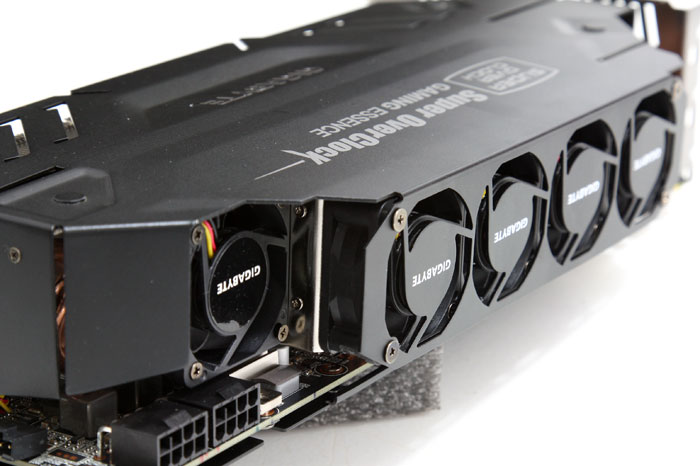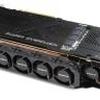Final words and conclusion
Final words and conclusion
There's been a lot of chatter in the community about the SOC editions with the massive cooler and 5 fans. Honestly I have to hand it to Gigabyte, I love the innovation and doing things differently -- so for that alone I applaud them. The SOC edition works well, it's amongst the fastest clocked GTX 680 cards we have tested.
The cooling performance is definitely impressive. I mean we do reach 68 Degrees C under full GPU load, but that's only because Gigabyte wants to keep the fan RPM on the five fans as low as possible to keep noise down. Once you crank them open then the temps fly downwards rapidly. Unfortunately the noise level then rises nearly exponentially at undesirable levels.
At default and overall the card is not silent, it's not massively noisy either but it's certainly there. That you have to keep in mind if you are a bit of an audiophile. A product like this is however targeted at certain audience and it's the pro-overclockers and tweakers that find extreme air based cooling like shown here enticing and wonderful.
The big quandary however with NVIDIA'S HIGH-END series is that NVIDIA is closing down everything in higher-level tweaking matters. There is a voltage limitation set at 1.175V, as a result you can boost 100Mv on the GPU core but that's it. Next to that there is a limit on the power usage, it's set at 124% and once you pass that power envelope the GPU automatically starts clocking down to match that 124% maximum power usage.
Honestly, if these limitations weren't enforced and we'd get 1.30~1.35 Volts on the GPU to play with with say a 200% power usage limit, then you'd be able to get 1400~1500 MHz out of cards like these with ease. Well, perhaps not with ease, but it would definitely be doable. The impressive board design from Gigabyte certainly can take it, and when cranked upwards the cooling can take it as well. Unfortunately it is what it is. So open up the Power limit to 124% and set Voltage a 100Mv higher. That in combo with a little added MHz on the core will get you at roughly 1300 MHz when overclocking, but ever there the GPU will clocking down here and there once it meets its maximum power enveloppe.
Good news then, the factory overclock is significant, the reference products are all clocked at 1006 MHz and this card comes with a factory clock set at 1132 MHz while it boosts towards roughly 1200 MHz. While doing so temperatures actually stay under 70 Degrees C which is absolutely fine. Power consumption as well impressed us, with the GPU at 100% load our X58 Core i7 based AMD test PC was consuming roughly 300~350W. When we input the variables and reverse calculate the TDP, we end up at a score of give or take 175W for this graphics card, and that's worth mentioning.
A rather big miss for Gigabyte is the 2GB memory framebuffer, while 2GB is fine for gaming up-to a 2560x1600 resolution, then you go higher or use multiple monitors and then that where memory starts to matter. So we certainly expected a product of this caliber and price to be fitted with 4GB of graphics memory, this is enthusiast grade hardware.

As mentioned quite a bit in this review, the card comes factory overclocked for you. The GPU core has been set a good notch higher, overall resulting into a slight boost in performance compared to the reference products. With any GTX 680 review I mention it, the Dynamic Clock Adjustment (boost) technology remains a little weird to observe, it however is a clever trick for the card to clock a little higher when the power envelope justifies it. The Gigabyte GeForce GTX 680 SOC edition baseclock is 1132 MHz (1006 MHz = NV reference) and the "Boost" clock at 1202 (1058 MHz reference) gives the card way more headroom to play with.
The end result is a card that performs well, there's not a game out there that it can't deal with. Anno 2070 at the best quality settings and 4xAA pushes 100 frames per second on average at 1920x1200, and still 62 fps at 2560X1600. In Crysis 2 we end at an average of 66 FPS in 1920x1200 with Ultra quality settings and that high resolution texture package and 4x AA. Battlefield 3 is another example, with all eye candy opened up in game and again at 4xAA the card still pushes 60 FPS at 19x12 and that makes it the amongst the fastest single GPU based graphics card on the market.
Right, it's time to wrap it up. The Gigabyte GeForce GTX 680 SOC edition is superb really, but caters a small segment of the market. You need to be able to accept higher then normal noise levels as the card does make noise.
Our biggest dilemma remains NVIDIA's limitations. This card can do so much more then it is allowed to do. But if all cards become relatively equal in tweaking matters then why invest a great deal of money and accept higher noise levels if the same product with that superb Gigabyte WindForce cooler achieved nearly the same tweak levels at pretty much no noise and excellent cooling levels ?
At the time of writing I do not have a pricing just yet, but we expect the card to be really expensive. But I'll refrain from comments on that until I hear the final pricing. Much like other high-end SKUs I will say this, this card is not just about playing games, it's all about that other sport, tweaking and fooling around with it to break and set records. With NVIDIA setting all kinds of restrictions in tweaking matters lately it create a dilemma. The reality remains though that the Gigabyte GeForce GTX 680 SOC edition is  amongst the fastest retail GeForce GTX 680 cards we tested to date and a build quality that is impressive.
amongst the fastest retail GeForce GTX 680 cards we tested to date and a build quality that is impressive.
So if the product suits your needs and requirements, we can very much recommend the Gigabyte GeForce GTX 680 SOC as it is a truly impressive product. But realistically I would advise a lower noise product and not spend too much on tweaking features. Look at factory overclocks, cooling and boards design -- we say.
- Leave/read comments on this product
- Sign up to receive a notice when we publish a new article
- Or go back to Guru3D's front page

